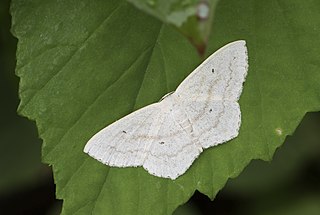
The geometer moths are moths belonging to the family Geometridae of the insect order Lepidoptera, the moths and butterflies. Their scientific name derives from the Ancient Greek geo γεω, and metron μέτρον "measure" in reference to the way their larvae, or inchworms, appear to measure the earth as they move along in a looping fashion. A very large family, it has around 23,000 species of moths described, and over 1400 species from six subfamilies indigenous to North America alone. A well-known member is the peppered moth, Biston betularia, which has been subject of numerous studies in population genetics. Several other geometer moths are notorious pests.

Lipomelia is a monotypic moth genus in the family Geometridae. It contains only one species, Lipomelia subusta, which is found in India and Taiwan. Both the genus and species were first described by William Warren in 1893.

Plataea is a genus of geometrid moths in the family Geometridae. There are about 11 described species in Plataea.

Scotocyma is a genus of moths in the family Geometridae described by Turner in 1904. All the species in this genus are found in Australia.

Sterrhinae is a large subfamily of geometer moths with some 3,000 described species, with more than half belonging to the taxonomically difficult, very diverse genera, Idaea and Scopula. This subfamily was described by Edward Meyrick in 1892. They are the most diverse in the tropics with the number of species decreasing with increasing latitude and elevation.
Scopula adelpharia is a moth of the family Geometridae. It was described by Püngeler in 1894. It is found in North Africa, the Near East and Middle East.
Scopula albiflava is a moth of the family Geometridae. It was described by Warren by 1896. It is found in India (Assam).
Scopula amala is a moth of the family Geometridae. It was described by Edward Meyrick in 1886. It is found on New Guinea and Australia.
Scopula anisopleura is a moth of the family Geometridae. It was described by Hiroshi Inoue in 1982. It is endemic to Japan.
Scopula anoista is a moth of the family Geometridae. It was described by Prout in 1915. It is found in Cameroon, Equatorial Guinea and Ivory Coast.
Scopula aphercta is a moth of the family Geometridae. It was described by Prout in 1932. It is found in Nigeria, Democratic Republic of Congo and Uganda.
Scopula apicipunctata is a moth of the family Geometridae. It was described by Hugo Theodor Christoph in 1881. It is found in Siberia, the Kuriles and Japan.
Scopula apparitaria is a moth of the family Geometridae. It was described by Francis Walker in 1861. It is found in South and Central America, the Greater Antilles and Florida. The type location is Honduras.
Scopula asthena is a moth of the family Geometridae. It was described by Hiroshi Inoue in 1943. It is found in Japan, north-eastern China and south-eastern Russia.
Scopula confusa is a moth of the family Geometridae. It was described by Arthur Gardiner Butler in 1878. It is found in southern Japan and the Russian Far East.
Scopula consimilata is a moth of the family Geometridae. It was described by Warren in 1896. It is found in India.

Scopula flaccidaria is a moth of the family Geometridae. It was described by Zeller in 1852. It is found in the Asia Minor, Russia and south-eastern Europe.
Scopula impersonata is a moth of the family Geometridae. It is found in China, the Russian Far East, Taiwan and Japan.
Scopula modicaria is a moth of the family Geometridae. It was described by John Henry Leech in 1897. It is found in China, the Russian Far East, Korea and Japan.
Scopula superior is a moth of the family Geometridae. It was described by Arthur Gardiner Butler in 1878. It is found in Japan, the Russian Far East and China.





